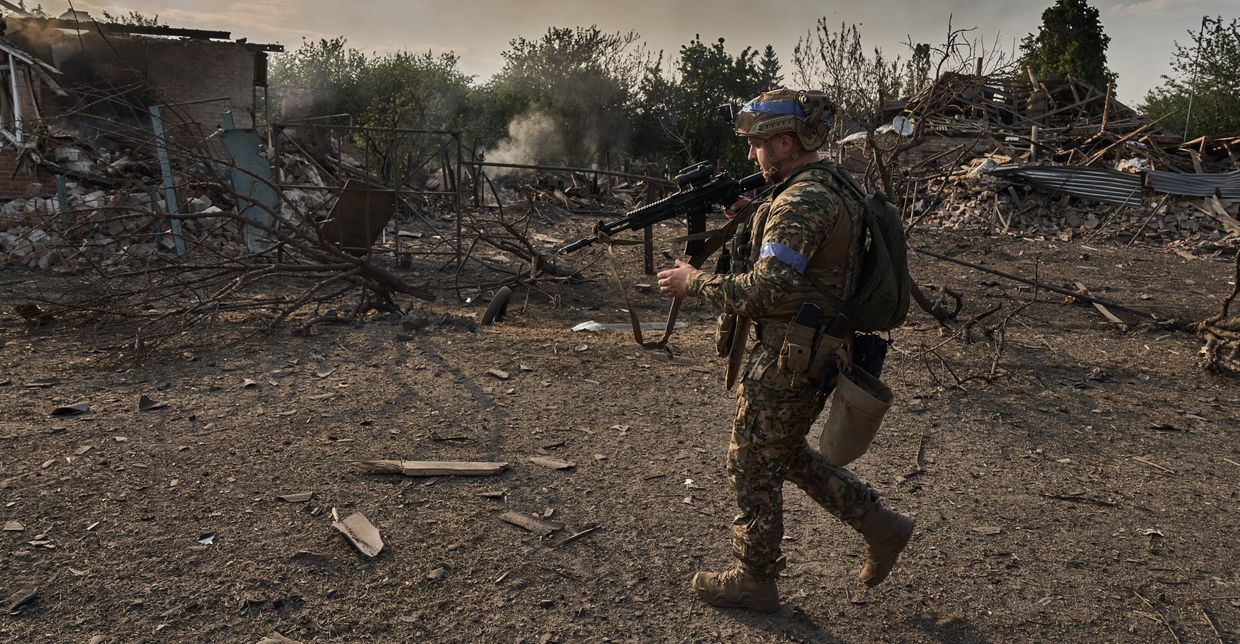
Russia's move on Kharkiv has bogged down. But was it a failure?
Ukrainian soldiers from the 13th Brigade of the National Guard fire artillery in their fighting position in the direction of the Russian border in Kharkiv, Ukraine, on June 3, 2024. (Jose Colon/Anadolu via Getty Images)
In the first half of May, Russia opened a new front to its war against Ukraine in dramatic fashion.
The two-pronged offensive on Kharkiv Oblast unfolded on the back of some of the most difficult months for Ukrainian forces, overstretched and depleted after a brutal winter and early spring campaign fought with severe ammunition shortages.
The initial offensive was particularly painful for Ukrainians, taking areas that had already once been occupied and liberated by the Ukrainian army, and accompanied by escalating attacks on civilian targets in Kharkiv city itself.
But just two weeks after it started, Russia’s move on Ukraine’s second-largest city stopped moving, meeting fierce resistance from a number of hardened Ukrainian brigades and specialist units sent there from the eastern and southern fronts.
Soon after, Kyiv declared that its forces had gone on the counterattack in some areas, particularly around the border town of Vovchansk, the majority of which Ukrainian forces control as of June 13, according to open source information.
By June 8, President Volodymyr Zelensky declared that Russia had “failed” in its offensive on Kharkiv, adding that Ukrainian forces were effectively “holding and destroying” the enemy in the area.
Making a judgment regarding the failure or success of an operation depends on the initial strategic goals of the operation in the first place.

Analysts and officials were generally in agreement that Russian forces had little to no chance — and thus no intent — to actually surround or enter Kharkiv itself.
Exactly how far Moscow truly hoped to advance is difficult to say, but the offensive has been often framed by experts in the larger context of Russia’s attempt to create broader strategic dilemmas for Kyiv, whose army remains stricken by chronic manpower issues.
“It's not surprising that the Kharkiv offensive did not advance that far,” said military expert Rob Lee, senior fellow at the Foreign Policy Research Institute, to the Kyiv Independent, “because we knew that Ukraine had a better defense prepared and we knew pretty early on that Ukraine moved a number of units to strengthen that defense.”
“It was more a question of how far would Russia be able to advance elsewhere? Would they be able to capitalize on that? And I don't think they've really capitalized.”
Results on the ground
As of June 13, according to open source mapping project DeepStateMap, Russian forces have occupied at least 183 square kilometers of Ukrainian territory in Kharkiv Oblast, with more territory labeled as a contested “gray zone.”
The gains made are split roughly evenly between two axes.
Immediately north of Kharkiv, Russian forces advanced a maximum distance of around ten kilometers, eventually being stopped outside the village of Lyptsi, itself around 20 kilometers from the Northern Saltivka neighborhood on the outskirts of Kharkiv.

Russia’s failure to get any closer means that Kharkiv remains outside the range of all of Russia’s abundant conventional tubed artillery, as well as Grad multiple-launch rocket artillery, preventing the same kind of wanton barrages the city suffered in the first month of the full-scale invasion from being possible again.
On the other axis further east, fighting continues for Vovchansk, over 70% of which is under the control of Ukrainian forces, according to Nazar Voloshyn, spokesperson for Ukraine’s Khortysia group of forces.
Well-coordinated with electronic attacks that allegedly disabled the Starlink communications of some of the Ukrainian units defending the town, Russia’s early push found success initially, much thanks to the reported lack of properly prepared defensive lines in the areas along the border.
Still, as Lee argued, the lack of coordinated combined arms assaults and the continuing reliance on small infantry group assault groups ultimately limited the offensive progress that Russian forces could make.
“Russia still has issues scaling operations because of lack of leadership and lack of training (among their ranks),” said Lee.
“Russia was taking heavy attrition over the war, there is a lack of time for units to train together, so you have a varied force quality of the units that are committed.”
Ultimately, Lee said, Ukraine’s commitment of some of its most combat-capable units meant that stopping Russia’s attack was the logical result.

Among others, brigades sent by Kyiv to Kharkiv Oblast included the 42nd Mechanized, 92nd Assault, and Khartiia Brigade of the National Guard, all of which had been fighting for months in hotspots in Donetsk Oblast, as well as the 82nd Air Assault Brigade, which had played a leading role in the southern counteroffensive last summer.
“When we started getting a better understanding of what Ukraine had moved up there, it became clear that Ukraine would be able to hold,” Lee said.
Capitalizing on dilemmas
Forcing Ukraine to whisk its best brigades out of fighting in Donetsk Oblast was exactly Russia’s hope when opening its new front north of Kharkiv, Lee says.
“It was more a question of whether, by moving all these units up there, does that put Ukraine in a more vulnerable position elsewhere?”
In this framing, the true metrics for success by which Moscow’s offensive can be measured is not in Kharkiv Oblast at all, but in Donetsk Oblast, where multiple Russian offensives launched in spring continue at high intensity.
Northwest of the occupied city of Avdiivka, Russian forces continue to expand on a large bulge around the village of Ocheretyne, where a localized breakthrough in April gave Russia the platform for some of its fastest territorial gains since summer 2022, bringing them within 10 kilometers of a key highway between the cities of Pokrovsk and Kostiantynivka.
Around 40 kilometers north of the Ocheretyne salient, Moscow’s offensive on the strategically crucial city of Chasiv Yar has also made progress, albeit still failing to enter the city proper or cross the Siverskyi Donets-Donbas canal.


“The risk when the Kharkiv offensive began was that Russia might get a foothold in Chasiv Yar itself,” said Lee.
“Once Russian forces get into cities, they become more difficult to hold, as opposed to when they are still crossing open ground.”
Russian forces have also advanced in other areas of the front, including in the city of Krasnohorivka west of Donetsk, and the village of Staromaiorske on the southern front line, the ruins of which were recaptured by Ukrainian forces in the summer counteroffensive last year.
But overall, says Lee, none of these gains amount to the kind of greater collapse in the Ukrainian defensive front that Moscow was likely hoping for.
“The worst-case scenario didn't happen,” he said. “It made sense for them to commit forces in other directions to try and capitalize on it (Ukrainian redeployments to Kharkiv). “They didn't really do that to the extent that I expected.”
Signs for the future
On June 8, Kharkiv Oblast Governor Oleh Syniehubov declared that Russian offensive operations in the region had been “reduced.”
Since the offensive began, Russia has lost almost 2,500 troops and over 500 pieces of equipment in the area, according to openly available figures from Ukraine’s General Staff compiled by Gwara Media on June 12.
Ukraine’s successful redeployment of combat units to Kharkiv Oblast and stabilization of the front means that not only will the area be easier to defend in the future, but that those units can soon be moved back to higher priority sectors, said Lee.
“Ukraine can now pull back some of these units or maybe develop a better rotation up there,” he said.
Still, the overall manpower issues plaguing Ukraine’s army look to remain in the near future, at least until the training of tens of thousands of new troops drafted under Ukraine’s new mobilization law can start to finish up later in summer.

“Ultimately Ukraine still has an issue where it is piecemeal deploying battalions from brigades in different directions as a kind of firefighting method,” Lee said, “and there are long-term issues that come about by doing so.”
In the meantime, Russia’s torrid experience in Kharkiv Oblast means that Moscow is unlikely to attempt to pull off a similar kind of diversionary attack on a new front any time soon, as some had initially speculated to be a threat in Sumy Oblast, said the expert.
“I think the priorities are still Pokrovsk and Donetsk Oblast overall,” he said.
“Committing some elements elsewhere on the border makes some sense as a diversion, to draw away Ukrainian reserves and so on. But overcommitting doesn't really make that much sense.”
Note from the author:
Hi, this is Francis Farrell, cheers for reading this article. I hope that news about Russia making gains across the front line hasn't come as a surprise to you. Things are moving fast, and not in the direction we would like, but whatever happens, we are dedicated to continue being Ukraine's voice to the world, no matter how dangerous and dark this war gets. Please consider supporting our reporting.












